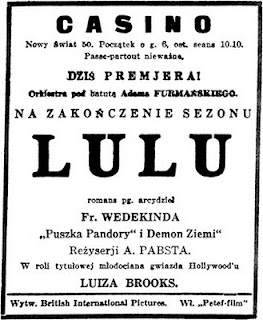As a follow-up to the just concluded 4 part series of posts featuring Polish film posters of the 1920s and 1930s, and as a nod to the forthcoming Polish Film Festival in London which is about to take place (I wish I could be there), I present this Louise Brooks Society blog post from 2010 titled "Discovering a Polish Lulu."
========================================
For those interested in European film history, in silent film, and in Louise Brooks - Marek Haltof’s Polish National Cinema (Berghahn Books) offers a little something for everyone. Haltof’s 300-page survey is the first comprehensive English-language study of Polish filmmaking and film culture from the end of the 19th to the beginning of the 21st century. It’s also a groundbreaking work well worth checking out - whatever your interst.
The book's first two chapters, “Polish Cinema before the Introduction of Sound” and “The Sound Period of the 1930s,” are each fascinating and detailed accounts of the origins and development of the Polish cinema.
Buffeted as it was between Germany and Russia and by the more dominant film industry’s found in each of those countries, Polish cinema was, naturally, influenced by its neighbors. German and Russian as well as French and American films all showed in Poland – and each left their mark. It’s known, for example, that at least a few of Louise Brooks’ American silent films as well as her German-made movies were shown in Warsaw – the capitol of both Poland and the Polish film industry.
For example, Pandora’s Box, retitled Lulu, opened at the Casino Theater in Warsaw at the end of May, 1929. It ran for a few weeks, and was well received. In my research, I have been able to track down the Polish newspaper reviews and advertisements for that historic screening.
One striking example given by Haltof of the German influence on Polish cinema is noted in the book’s second chapter, on the films of the 1930s.
Haltof writes, “The treatment of women in Polish melodramas oscillates between presenting them as femme fatales in the tradition of Pola Negri’s silent features made for the Sfinks company, and as vulnerable figures at the mercy of the environment. The former representation, which is not very popular in Polish cinema, can be seen in Zabawka (The Toy, 1933), directed by Michal Waszynski. The title refers to the female protagonist Lulu (Alma Kar), a Warsaw cabaret star, who is invited to a country manor by a wealthy landowner. The landowner’s son and local Don Juan both fall in love with Lulu and pay for it. The name of the protagonist and the theme of the film suggest G.W. Pabst’s influence (Louise Brooks as Lulu in Pandora’s Box, 1929), and this inspiration has been emphasized by one of the scriptwriters of the film.” Pictured here is Alma Kar as Lulu in Zabawka.
Haltof, a Polish-born scholar, is now resident in the United States where he teaches Film in the English Department at Northern Michigan University. Via email, he confirmed the influence of one film on the other. He also supplied a photocopy of a page from a hard-to-find Polish work, Historia filmu polskiego (1988), which he cites in his own book. It quotes coscriptwriter Andrzej Tomakowski on the influence of Pandora’s Box on Zabawka.
A viewing of Zabawka itself confirms the influence (see video clip below - the entire film resides, in parts, on YouTube). The character, played by the charming Alma Kar, is named Lulu and is like Pabst’s version of Lulu a showgirl desired by many (including a Father and his son) with disastrous results. In one early scene, this Polish Lulu is surrounded by a line of chorus girls each wearing a sharp bob haircut just like that worn by Brooks in Pandora’s Box – except each of these Polish chorines are blonde!
Marek Haltof’s Polish National Cinema was first published in 2002, and was reprinted in softcover in 2008 by Berghahn Books. It is available online and at select independent bookstores.



